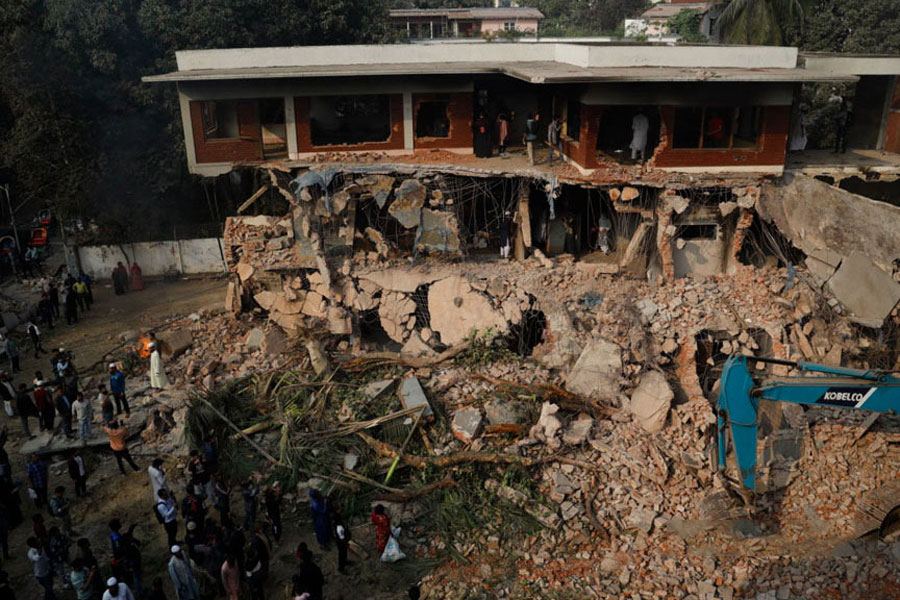Asked what police did at Dhanmondi Road 32, DMP chief says, 'We tried'

Published :
Updated :

Asked what initiative police had taken to prevent the attack and vandalism of Sheikh Mujibur Rahman’s home on Dhanmondi Road No. 32 on Wednesday night, Dhaka Metropolitan Police Commissioner Sheikh Md Sazzat Ali said that they had tried.
“We tried to bring the situation under control,” he said on Thursday. “We tried. I was there myself late into the night.”
When asked if he had heard about attacks on journalists, the DMP chief said: “I was there until around 2-2:30am. I didn’t receive any information on attacks on journalists.”
The commissioner took questions from the media on Thursday at the inaugural ceremony for the counters and e-ticket counters of a new bus services in Dhaka’s Uttara.
In response to an online speech by deposed premier Sheikh Hasina made from exile in India, a demolition campaign dubbed the “Bulldozer March”, began with vandalism at the home of Bangladesh’s first president. The demolition continued on Thursday in the presence of many people.
An excavator and crane were used to demolish the residence of Bangabandhu Sheikh Mujibur Rahman in an operation that started late on Wednesday night and rolled into the early hours of Thursday.
The programme was not limited simply to the house on Road 32. Hasina’s residence Sudha Sadan was set on fire on Dhanmondi Road No. 5. Outside Dhaka, homes of Hasina’s relatives and Awami League leaders, as well as various sculptures, have been vandalised in Khulna, Jashore, Kushtia, Barishal, and Sylhet.
The developments come on the day marking six months since the Hasina government fell and she went into exile amid mass protests.
A BBC Bangla report on Tuesday stated that Hasina was scheduled to address an online event on Wednesday night. This prompted a strong reaction from the Anti-discrimination Student Movement, which led the July-August uprising in 2024 that resulted in the fall of the Hasina government.
Hasnat Abdullah, convenor of the group, wrote in a Facebook post: “Allowing Hasina to deliver a speech is an act of war by India against the anti-fascist people of Bangladesh.”
Later, at 6:30pm on Wednesday, Hasnat posted again, saying: “Tonight, Bangladesh’s shrine of ‘fascism’ will be liberated.”
Earlier in the afternoon, controversial content creators Elias Hossain and Pinaki Bhattacharya announced the ‘Bulldozer March’ towards Dhanmondi-32 on Facebook.
They shared a photo card that read: “Following the ‘genocide’ of thousands of students and activists, killer Hasina has fled to Delhi, from where she continues her anti-Bangladesh activities. In protest, the revolutionary students of 2024 will march towards Dhanmondi-32 at 9pm tonight.”
The “Bulldozer March” began at Dhanmondi-32, but soon reports of vandalism and arson emerged from across the country.
A large number of people gathered in front of Sheikh Mujib’s house from 8pm, broke through the public gate and started vandalising it. Sticks and axes were used and people started breaking up and carrying away parts of windows, grills, wood, and gates.
The house had previously been set on fire on Aug 5 after the Awami League government fell. Following the vandalism, fires were set inside once again. The building next to the house was also set on fire.
About 3,000 people had gathered around the building when a crane and excavator began to demolish it around 11:15pm. More than half the building was demolished overnight.
Despite prior statements about heightened security in Dhanmondi, only two police vans were seen on the street, with no significant law-enforcing presence in the area.
Around midnight, when army personnel arrived in front of the house on Road No. 32, students and protesters chanted “fake, fake” slogans.
The army withdrew shortly after.
The crowd of people going towards Dhanmondi Road 32 brought traffic in the Russel Square area to a halt and interrupted the flow of traffic across the city, with tailbacks trailing along Mirpur Road to the Science Laboratory intersection.
The programme drew many reactions from many different quarters, including from interim government advisor Mahfuj Alam, who Chief Advisor Muhammad Yunus has described as the “mastermind” of the July uprising.
Mahfuj wrote, “After the destruction, we have a chance to rebuild. But a project of endless destruction does not suggest a good future for us. Building projects will start and be implemented very soon. You should take an active part in this building process.”


 For all latest news, follow The Financial Express Google News channel.
For all latest news, follow The Financial Express Google News channel.